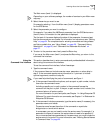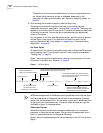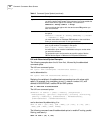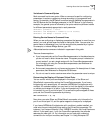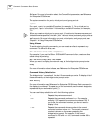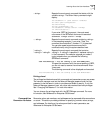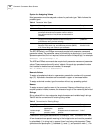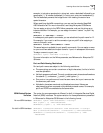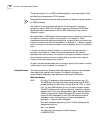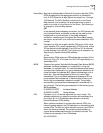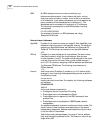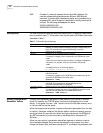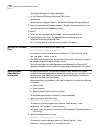
Learning About the User Interfaces 29
example, to include an apostrophe in string text, enter a backslash followed by an
apostrophe (\'). To include a backslash (\) in string text, enter two backslashes (\\).
The first backslash prevents the bridge/router from treating the second as a
special character.
When specifying AppleTalk zone strings, you can use the extended AppleTalk
ASCII character set. For more information, see Using Enterprise OS Software.
You can assign a string to the PATH NAme parameter, and use this string as an
instance identifier. For example, you can assign the name “testnet” to path 2 by
entering:
SETDefault !2 -PATH NAme = “testnet”
In subsequent path-specific commands, you can substitute the path name for !2.
For example, if you want to set the connector type on path 2 after assigning a
name to this path, enter:
SETDefault !testnet -PATH CONNEctor = RS232
This same feature is available for port-specific commands. You can assign a name
to a port and then substitute the port name for !<port> in subsequent commands.
To assign a name to a port, use:
SETDefault !<port> -PORT NAme = “<string>”
For more information on the NAme parameter, see Reference for Enterprise OS
Software.
Port and Path Naming Restrictions
Port and path names are subject to the following restrictions:
■ The name string can contain a maximum of eight characters, the first of which
must be alphabetic.
■ No blank spaces are allowed. The only nonalphanumeric characters allowed are
the asterisk (*), underscore (_), period (.), and hyphen (-).
■ Two ports or two paths cannot have the same name, but a port name can be
the same as a path name.
■ Alphabetic characters are stored and displayed as entered. Names are
case-insensitive when compared with previously entered names. For example,
port2 and PORT2 are evaluated as the same name.
ISDN-Related Syntax
Variation
The syntax for some parameters is different for built-in Integrated Services Digital
Network (ISDN) interfaces. The syntax variation for these parameters is presented
in Reference for Enterprise OS Software in the following format:
For non-ISDN interfaces SETDefault !<path> -PATH remoteDialNo = “<string>”
SHow [!<path> | !*] -PATH remoteDialNo
SHowDefault [!<path> | !*] -PATH remoteDialNo
For built-in ISDN interfaces SETDefault !<connectorID.channelID> -PATH remoteDialNo = “<string>”
SHow [!<connectorID.channelID> | !<connectorID>.*] -PATH remoteDialNo
SHowDefault [!<connectorID.channelID> | !<connectorID>.*] -PATH
remoteDialNo



